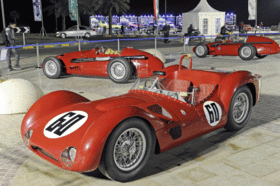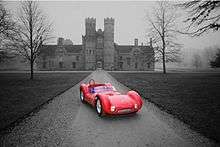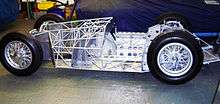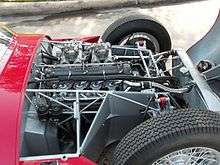Maserati Birdcage Tipo 61 2459
| Maserati Birdcage Tipo 61 2459 | |
|---|---|
 | |
| Overview | |
| Manufacturer | Maserati |
| Also called | Birdcage |
| Production | 1959-1960, only 22 cars made [1] |
| Body and chassis | |
| Class | Sports racer. |
| Chassis | VIN n: 2459 |
| Powertrain | |
| Engine | 2 liter 4 in line cylinder, compression ration: 9.8:1, 45 degree angle, 200 hp, max speed: 240 kph (144mph), max rpm: 7800, max bhp: 200.[2] |
| Dimensions | |
| Wheelbase | 2200 (88 in) |
| Length | 3800mm (152 in) |
| Width | 1500mm (60 in) |
| Height | 900mm (36 in) |
The Maserati Tipo 60/61 “Birdcage” is a light and powerful sports racer produced in 1959-1960 that exhibits superb aerodynamics. It has a great power to weight ratio, with a perfect 50/50 weight distribution front-to-back, independent front suspension, 4-wheel disc brakes, and De Dion tubes in front of a 5-speed transaxle made of electron, which is a special aluminum alloy.[2]
The nickname "Birdcage" is due to the intricate, tubular frame and chassis made up of approximately 200 small-diameter, chrome-molybdenum steel tubes of varying lengths and thicknesses welded together with a unique and highly guarded Italian process. This design was engineered by Giulio Alfieri in 5 different models, the most popular being the Tipo 60 and the Tipo 61.[2]
Many of these drivers are quoted as saying very positive things about the car.[3]
2459 History Overview
Maserati Tipo 61 Chassis #2459 was built for Briggs Cunningham and prepared for racing by Alfred Momo. 2459 was primarily driven by two-time SCCA Driver of the Year Walt Hansgen, with Dr. Dick Thompson and Augie Pabst also driving. Under Hansgen, Thompson, and Pabst, Birdcage #2459 achieved four wins and one finish each for second, third, and fourth place in 1960 and 1961.[2]
In 1962, Birdcage 2459 was taken to Daytona to compete in the first 3-hour Continental on February 11 with Augie Pabst as the driver. After 2 years of success, Maserati Tipo 60-2459 had an accident during a practice run for this event. Pabst walked away from the accident with cuts, bruises, and a few broken ribs, while the car, 2459, was destroyed. The remains were taken back to Momo's shop in New York. Momo decided not to repair the car and instead dismantled it, scrapped the chassis and body, and sent the component parts to England for potential use on Maserati Tipo 60 and 61 Birdcages.[4][5]
It wouldn't be until many years later that Maserati "Birdcage" Tipo 61 Chassis #2459 began restoration for a distinguished, but anonymous, Italian collector.



2459 Restoration
The restoration of the Maserati Tipo 61-2459 "Birdcage" began in 2007 in Modena, Italy-home of the Maserati factory. An Italian collector spent years painstakingly collecting original Maserati Birdcage parts for 2459 before even beginning the restoration. Then Italian professional welders rebuilt chassis 2459 using the same secret welding processes and small diameter chrome-molybdenum steel tubes that were unique to the production of the Birdcages in the 1960s.
The original parts the Italian collector assembled for 2459 were mostly engine parts, unfortunately he couldn't find a type 61 engine so he substituted a type 60, and included an original cylinder head, lower crankcase and sump, cam covers, and transaxle tower (also known as a differential case), which included the cast numbers for the original birdcage parts used to verify the parts as original type 60. Frank Tralli of Modena, Italy rebuilt the engine to original birdcage specifications from both these original parts and other parts manufactured according to the original drawings.[6] He then Dyno'd the engine for racing which can be found in the Maserati Tipo 61-2459 Dyno Report.
The completed chassis and engine were then shipped to the Maserati restoration experts at Steve Hart Racing in England. In completing the restoration, the restoration facility added additional original Birdcage parts including rear lights, repeater lights, rev counter, ignition switch (also known as the light switch), starter button, indicator switch (also known as turn signal), and front hubs. This information is verified in a letter written and signed by the restoration facility owner.[7]
The completely restored Maserati Tipo 61-2459 "Birdcage" was then submitted to the Motor Sports Association in April 2010, who carried out an extensive inspection. The Maserati Tipo 61-2459 passed the inspection and the new owners were issued the Historic Technical Passport/FIA Class: TSRC4 Documents on August 27, 2010.[1] The document certifies that a car conforms technically with the period specification,but it does not in any way certify the history or provenance of a car.
The Challenges of Restoring Birdcages
Maserati Tipo 61-2459, along with the other Maserati Birdcages, were intended for racing, not for becoming an investment vehicle. Race cars, unlike other classic cars, have no across-the-board standard for what is and isn't a proper restoration. This is because the owners, drivers, and maintainers of these Birdcages had no idea that the car they were racing would one day become an investment grade car. They only had one goal in mind-to win the race! Therefore, the cars would get banged up, wrecked, patched, rebuilt, and/or restored multiple times, and more often than not without documentation. Again, the goal was to get the work done as quickly as possible and get the car back on the race track! Time was money. Thus, by the mid-1960s, many of these cars had little to no original parts to speak of.[2]
In fact, Joel Finn states in his book "Maserati Birdcage" Published by Osprey in 1980 that by 1962: "Engine swaps began to become common in an effort to make them faster, but these were usually failures because it caused transaxle and half-shaft breakages. None of this caused engine swap proponents to abandon trying, but did lead to the destruction of a number of Birdcages. Either that or they were modified so greatly that it would be very difficult to ever put them back to original again." Finn also states that the only reason the Birdcages came back were because they became desirable cars in vintage racing in the late 1960s and throughout the 1970s.[8]
By then, however, most of the damage to the original cars had been done. He has well documented all the problems in his book "Maserati Birdcage: The Marvelous Tipo 60 and 61 Sports Racing Cars," published by Osprey, according to chassis numbers and traces each car up to the publish date of 1980 for this book.[9] Also in Finn's book he states about Birdcage #2455 "this Tipo 61, except for new tires, is still in totally original condition, the only existing example in such shape."[10]
Many of these vehicles have gaps in their ownership history and few have complete documentation covering every aspect of their restoration, even after the 1970s when they became desirable as vintage racing cars.[9] On top of the lack of exact knowledge surrounding each restoration, reconditioning, and rebuilding of these cars the chassis numbers many not even be valid and are a poor point of identification of the cars since multiple cars were raced under one chassis number.
In fact, Fred Gamble, famous Birdcage driver known for his CAMORADI appearances, stated in the IL Tridente Magazine 1996 "relying on chassis numbers for Maseratis is the downfall of most historians. The Maserati factory shipped team CAMORADI cars on its international Carnets which were few in number. Chassis #2451 is the best example. The practice was to weld a number plate on any chassis that was being shipped for a team entry, using the number on the Carnet. So the number plate from race to race was not always the same car. No deception here, just paperwork simplification."[11]
So not only do we have few records and much missing history on many of the Birdcages, but even during the time the cars were raced the chassis numbers were switched about. This makes both performing and judging a Birdcage Restoration difficult. There are many theories and ideas about what makes a restored Birdcage credible, but here again there is no official standard.
How the 2459 Restoration is Different
Given the fact that there is no standard for Maserati Birdcage restoration, the factor that sets Maserati Tipo 61 Chassis #2459 apart is the documentation offered about the car.[1] Birdcage 2459 was built for the vintage racer with correct and accurate restoration in mind. Many original parts were used as well as original factory processes used by many original manufacturers of the engine and chassis in the original location. This is an important consideration, as Birdcage chassis construction is a very specific process known only to very specific people. When the chassis and engine were delivered to the restoration facility, any other parts needed for the restoration where original parts were not available were manufactured using original Maserati factory drawings and the restoration facility's "extensive knowledge gained from restoring other Maserati Birdcage race cars."[7]
This car carries the FIA stamp of approval, which allows it to be raced in many venues throughout the world. As far as whether or not Maserati Birdcage 2459 is restored to proper racing condition, in a letter written by Richard Crump known author and historian dated April 28, 2010 he states: "If you were a buyer of a Birdcage in the 1960's, then this car, 2459, is what it would be like. When you drive this fabulous car the message is clear. Light steering, fabulous brakes, big torque with useable power, and it sticks like glue to the tarmac. If you are a driver or a collector you will not easily tire of using such a Maserati, and when it comes to a stop you will just wish you could do it all again."[12]
References
- 1 2 3 "Historic Technical Passport" (PDF). Auto Collectors Garage. Retrieved 2013-10-14.
- 1 2 3 4 5 Finn, Joel (1980). Maserati Birdcage The Marvelous Tipo 60 and 61 Sports Racing Cars. Osprey Publishing Limited.
- ↑ Crump, Richard (January 2, 1976). Maserati: Sports, Racing and G.T.Cars, 1926-75. G T Foulis & Co Ltd.
- ↑ "Driver is Injured in Daytona Crash". The News and Courier. Retrieved 2014-01-06.
- ↑ "Pabst Injured as Car Hits Wall Doing 150 MPH". The Daytona Beach News-Journal.
- ↑ Franco, Tralli. "Maserati Tipo 61-2459 Dyno Report" (PDF). Autoriparazioni. Franco Tralli. Retrieved 14 October 2013.
- 1 2 Hart, Steve. "original parts used". Retrieved 2013-10-14.
- ↑ Finn, Joel (1980). Maserati Birdcage The Marvelous Tipo 60 and 61 Sports Racing Cars. Osprey Publishing Limited. p. 161.
- 1 2 Finn, Joel (1980). Maserati Birdcage The Marvelous Tipo 60 and 61 Sports Racing Cars. Osprey Publishing Limited. pp. 161–174.
- ↑ Finn, Joel (1980). Maserati Birdcage The Marvelous Tipo 60 and 61 Sports Racing Cars. Osprey Publishing Limited. pp. 166–167.
- ↑ Gamble, Fred. "Letter to the Editor". Il Tridente. Retrieved 2014-01-06.
- ↑ Crump, Richard. "Richard Crump Letter" (PDF). Retrieved 2014-01-06.